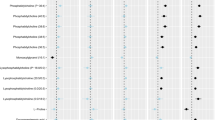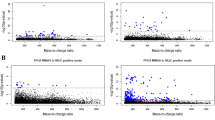Abstract
Objective
Welding fume exposure is inevitable of welding workers and poses a severe hazard to their health since welding is a necessary industrial process. Thus, preclinical diagnostic symptoms of worker exposure are of great importance. The aim of this study was to screen serum differential metabolites of welding fume exposure based on UPLC–QTOF-MS/MS.
Methods
In 2019, 49 participants were recruited at a machinery manufacturing factory. The non-target metabolomics technique was used to clarify serum metabolic signatures in people exposed to welding fume. Differential metabolites were screened by OPLS-DA analysis and Student's t-test. The receiver operating characteristic curve evaluated the discriminatory power of differential metabolites. And the correlations between differential metabolites and metal concentrations in urine and whole blood were analyzed utilizing Pearson correlation analysis.
Results
Thirty metabolites were increased significantly, and 5 metabolites were decreased. The differential metabolites are mainly enriched in the metabolism of arachidonic acid, glycero phospholipid, linoleic acid, and thiamine. These results observed that lysophosphatidylcholine (20:1/0:0) and phosphatidylglycerol(PGF1α/16:0) had a tremendous anticipating power with relatively increased AUC values (AUC > 0.9), and they also presented a significant correlation of Mo concentrations in whole blood and Cu concentrations in urine, respectively.
Conclusion
The serum metabolism was changed significantly after exposure to welding fume. Lysophosphatidylcholine (20:1/0:0) and phosphatidylglycerol (PGF1α/16:0) may be a potential biological mediator and biomarker for laborers exposure to welding fume.





Similar content being viewed by others
Data availability
Source data can be made available upon personal request.
References
Antonini JM (2003) Health effects of welding. Crit Rev Toxicol 33:61–103. https://doi.org/10.1080/713611032
Bradshaw LM, Fishwick D, Slater T, Pearce N (1998) Chronic bronchitis, work related respiratory symptoms, and pulmonary function in welders in New Zealand. Occup Environ Med 55:150–154. https://doi.org/10.1136/oem.55.3.150
Brand P, Bauer M, Gube M, Lenz K, Reisgen U, Spiegel-Ciobanu VE, Kraus T (2014) Relationship between welding fume concentration and systemic inflammation after controlled exposure of human subjects with welding fumes from metal inert gas brazing of zinc-coated materials. J Occup Environ Med 56:1–5. https://doi.org/10.1097/JOM.0000000000000061
Coggon D, Inskip H, Winter P, Pannett B (1994) Lobar pneumonia: an occupational disease in welders. Lancet (london, England) 344:41–43. https://doi.org/10.1016/s0140-6736(94)91056-1
Dehghani F, Yousefinejad S, Walker DI, Omidi F (2022) Metabolomics for exposure assessment and toxicity effects of occupational pollutants: current status and future perspectives. Metabolomics 18(9):73. https://doi.org/10.1007/s11306-022-01930-7
Diamond I, Messing RO (1994) Neurologic effects of alcoholism. Western J Med 161:279–287
Dong X, Chao Y, Zhou Y, Zhou R, Zhang W, Fischetti VA, Wang X, Feng Y, Li J (2021) The global emergence of a novel Streptococcus suis clade associated with human infections. EMBO Mole Med 13:e13810. https://doi.org/10.15252/emmm.202013810
Fatola OI, Olaolorun FA, Olopade FE, Olopade JO (2019) Trends in vanadium neurotoxicity. Brain Res Bull 145:75–80. https://doi.org/10.1016/j.brainresbull.2018.03.010
Ferrucci L, Cherubini A, Bandinelli S, Bartali B, Corsi A, Lauretani F, Martin A, Andres-Lacueva C, Senin U, Guralnik JM (2006) Relationship of plasma polyunsaturated fatty acids to circulating inflammatory markers. J Clin Endocrinol Metab 91:439–446. https://doi.org/10.1210/jc.2005-1303
Fessler MB, Summer RS (2016) Surfactant lipids at the host-environment interface. Metabolic sensors, suppressors, and effectors of inflammatory lung disease. Am J Respir Cell Mol Biol 54:624–635. https://doi.org/10.1165/rcmb.2016-0011PS
Furbee B (2011) Welding and parkinsonism. Neurol Clin 29:623–640. https://doi.org/10.1016/j.ncl.2011.05.007
Gao S, Zhuo Z, Hutchinson J, Su L, Christiani DC (2021) Metabolomic profiling identifies plasma sphingosine 1-phosphate levels associated with welding exposures. Occup Environ Med 78:255–261. https://doi.org/10.1136/oemed-2020-106918
Gonzalez-Granda A, Damms-Machado A, Basrai M, Bischoff SC (2018) Changes in plasma acylcarnitine and lysophosphatidylcholine levels following a high-fructose diet: a targeted metabolomics study in healthy women. Nutrients. https://doi.org/10.3390/nu10091254
Guha N, Loomis D, Guyton KZ, Grosse Y, El Ghissassi F, Bouvard V, Benbrahim-Tallaa L, Vilahur N, Muller K, Straif K (2017) Carcinogenicity of welding, molybdenum trioxide, and indium tin oxide. Lancet Oncol 18:581–582. https://doi.org/10.1016/S1470-2045(17)30255-3
Heitland P, Köster HD (2006) Biomonitoring of 30 trace elements in urine of children and adults by ICP-MS. Clinica Chimica Acta: Int J Clin Chem 365:310–318. https://doi.org/10.1016/j.cca.2005.09.013
IARC Monographs on the Evaluation of Carcinogenic Risks to Humans (2018): Welding, molybdenum trioxide, and indium tin oxide. Lyon (FR): International Agency for Research on Cancer; 2018.
Ishii S, Shimizu T (2000) Platelet-activating factor (PAF) receptor and genetically engineered PAF receptor mutant mice. Prog Lipid Res 39:41–82. https://doi.org/10.1016/s0163-7827(99)00016-8
Jones PT, Anderson R (1983) Oxidative inhibition of polymorphonuclear leukocyte motility mediated by the peroxidase/H2O2/halide system: studies on the reversible nature of the inhibition and mechanism of protection of migratory responsiveness by ascorbate, levamisole, thiamine and cysteine. Int J Immunopharmacol 5:377–389. https://doi.org/10.1016/0192-0561(83)90012-7
Li N, Taneepanichskul N (2021) Associations between welding fume exposure and blood hemostatic parameters among workers exposed to welding fumes in confined space in Chonburi Thailand. PLoS ONE 16:e0260065. https://doi.org/10.1371/journal.pone.0260065
Li X, Wang P, Tong Y, Liu J, Shu G (2022a) UHPLC-Q-exactive orbitrap MS/MS-based untargeted metabolomics and molecular networking reveal the differential chemical constituents of the bulbs and flowers of Fritillaria thunbergii. Molecules 27(20):6944. https://doi.org/10.3390/molecules27206944
Li XH, Wu CX, Hu Y, Liu XD (2022b) Comparative analysis on occupational hazards of three welding operations. Zhonghua Lao Dong Wei Sheng Zhi Ye Bing Za Zhi = Zhonghua Laodong Weisheng Zhiyebing Zazhi = Chinese Journal of Industrial Hygiene and Occupational Diseases 40:288–291. https://doi.org/10.3760/cma.j.cn121094-20201218-00700
Liu-Wu Y, Hurt-Camejo E, Wiklund O (1998) Lysophosphatidylcholine induces the production of IL-1beta by human monocytes. Atherosclerosis 137:351–357. https://doi.org/10.1016/s0021-9150(97)00295-5
Long C, Hu G, Zheng P, Chen T, Su Z, Zhang Y, Ding C, Peng F, Yu S, Wang T, Jia G (2021) Analysis of serum metabolome of workers occupationally exposed to hexavalent chromium: a preliminary study. Toxicol Lett 349:92–100. https://doi.org/10.1016/j.toxlet.2021.06.007
Marcé-Grau A, Martí-Sánchez L, Baide-Mairena H, Ortigoza-Escobar JD, Pérez-Dueñas B (2019) Genetic defects of thiamine transport and metabolism: a review of clinical phenotypes, genetics, and functional studies. J Inherit Metab Dis 42:581–597. https://doi.org/10.1002/jimd.12125
Markert A, Baumann R, Gerhards B, Gube M, Kossack V, Kraus T, Brand P (2016) Single and combined exposure to zinc- and copper-containing welding fumes lead to asymptomatic systemic inflammation. J Occup Environ Med 58:127–132. https://doi.org/10.1097/JOM.0000000000000652
Mochizuki H (2019) Arsenic Neurotoxicity in Humans. Int J Mole Sci 20(14):3418. https://doi.org/10.3390/ijms20143418
Praveen P, Yarlagadda P, Kang MJ (2005) Advancements in pulse gas metal arc welding. J Mater Process Technol. https://doi.org/10.1016/j.jmatprotec.2005.02.100
Quintana-Sosa M, León-Mejía G, Luna-Carrascal J, De Moya YS, Rodríguez IL, Acosta-Hoyos A, Anaya-Romero M, Trindade C, Narváez DM, Restrepo HG, Dias J, Niekraszewicz L, Garcia ALH, Rohr P, da Silva J, Henriques JAP (2021) Cytokinesis-block micronucleus cytome (CBMN-CYT) assay biomarkers and telomere length analysis in relation to inorganic elements in individuals exposed to welding fumes. Ecotoxicol Environ Safety 212:111935. https://doi.org/10.1016/j.ecoenv.2021.111935
Romero F, Shah D, Duong M, Penn RB, Fessler MB, Madenspacher J, Stafstrom W, Kavuru M, Lu B, Kallen CB, Walsh K, Summer R (2015) A pneumocyte-macrophage paracrine lipid axis drives the lung toward fibrosis. Am J Respir Cell Mol Biol 53:74–86. https://doi.org/10.1165/rcmb.2014-0343OC
Ruan Y, Fan Y, Xie Y, Ma C, Mo B, Lai Y, Li G, Liu X, Kuang W (2022) Modified Xiaoqinglong decoction alleviates lipopolysaccharide-induced acute lung injury in mice by regulating arachidonic acid metabolism and exerting anti-apoptotic and anti-inflammatory effects. Anatom Rec 305:1672–1681. https://doi.org/10.1002/ar.24822
Sakai M, Kakutani S, Horikawa C, Tokuda H, Kawashima H, Shibata H, Okubo H, Sasaki S (2012) Arachidonic acid and cancer risk: a systematic review of observational studies. BMC Cancer 12:606. https://doi.org/10.1186/1471-2407-12-606
SamulinErdem J, Arnoldussen YJ, Tajik S, Ellingsen DG, Zienolddiny S (2020) Effects of mild steel welding fume particles on pulmonary epithelial inflammation and endothelial activation. Toxicol Ind Health 36:995–1001. https://doi.org/10.1177/0748233720962685
Sarafian MH, Gaudin M, Lewis MR, Martin FP, Holmes E, Nicholson JK, Dumas ME (2014) Objective set of criteria for optimization of sample preparation procedures for ultra-high throughput untargeted blood plasma lipid profiling by ultra performance liquid chromatography-mass spectrometry. Anal Chem 86:5766–5774. https://doi.org/10.1021/ac500317c
Schmidt R, Ruppert C, Markart P, Lübke N, Ermert L, Weissmann N, Breithecker A, Ermert M, Seeger W, Günther A (2004) Changes in pulmonary surfactant function and composition in bleomycin-induced pneumonitis and fibrosis. Toxicol Appl Pharmacol 195:218–231. https://doi.org/10.1016/j.taap.2003.11.011
Schwemmer M, Aho H, Michel JB (2001) Interleukin-1beta-induced type IIA secreted phospholipase A2 gene expression and extracellular activity in rat vascular endothelial cells. Tissue Cell 33:233–240. https://doi.org/10.1054/tice.2000.0163
Shen S, Zhang R, Zhang J, Wei Y, Guo Y, Su L, Chen F, Christiani DC (2018) Welding fume exposure is associated with inflammation: a global metabolomics profiling study. Environ Health 17:68. https://doi.org/10.1186/s12940-018-0412-z
Shimizu T (2009) Lipid mediators in health and disease: enzymes and receptors as therapeutic targets for the regulation of immunity and inflammation. Annu Rev Pharmacol Toxicol 49:123–150. https://doi.org/10.1146/annurev.pharmtox.011008.145616
Song X, FiatiKenston SS, Kong L, Zhao J (2017) Molecular mechanisms of nickel induced neurotoxicity and chemoprevention. Toxicology 392:47–54. https://doi.org/10.1016/j.tox.2017.10.006
Vangaveti VN, Jansen H, Kennedy RL, Malabu UH (2016) Hydroxyoctadecadienoic acids: Oxidised derivatives of linoleic acid and their role in inflammation associated with metabolic syndrome and cancer. Eur J Pharmacol 785:70–76. https://doi.org/10.1016/j.ejphar.2015.03.096
Vorkas PA, Isaac G, Anwar MA, Davies AH, Want EJ, Nicholson JK, Holmes E (2015) Untargeted UPLC-MS profiling pipeline to expand tissue metabolome coverage: application to cardiovascular disease. Anal Chem 87:4184–4193. https://doi.org/10.1021/ac503775m
Wang KC, Kuo CH, Tian TF, Tsai MH, Chiung YM, Hsiech CM, Tsai SJ, Wang SY, Tsai DM, Huang CC, Tseng YJ (2012) Metabolomic characterization of laborers exposed to welding fumes. Chem Res Toxicol 25:676–686. https://doi.org/10.1021/tx200465e
Wang T, Fu X, Chen Q, Patra JK, Wang D, Wang Z, Gai Z (2019) Arachidonic acid metabolism and kidney inflammation. Int J Mole Sci 20(15):3683. https://doi.org/10.3390/ijms20153683
Wei Y, Wang Z, Chang CY, Fan T, Su L, Chen F, Christiani DC (2013) Global metabolomic profiling reveals an association of metal fume exposure and plasma unsaturated fatty acids. PLoS ONE 8:e77413. https://doi.org/10.1371/journal.pone.0077413
Xin C, Chu L, Zhang L, Geng D, Wang Y, Sun D, Sui P, Zhao X, Gong Z, Sui M, Zhang W (2019) Expression of cytosolic phospholipase A2 (cPLA2)-arachidonic acid (AA)-cyclooxygenase-2 (COX-2) pathway factors in lung cancer patients and its implication in lung cancer early detection and prognosis. Med Sci Monitor 25:5543–5551. https://doi.org/10.12659/MSM.915314
Xu MY, Sun YJ, Wang P, Yang L, Wu YJ (2020) Metabolomic biomarkers in urine of rats following long-term low-dose exposure of cadmium and/or chlorpyrifos. Ecotoxicol Environ Safety 195:110467. https://doi.org/10.1016/j.ecoenv.2020.110467
Yadav UC, Kalariya NM, Srivastava SK, Ramana KV (2010) Protective role of benfotiamine, a fat-soluble vitamin B1 analogue, in lipopolysaccharide-induced cytotoxic signals in murine macrophages. Free Rad Biol Med 48:1423–1434. https://doi.org/10.1016/j.freeradbiomed.2010.02.031
Yan Z, Zhao M, Wu X, Zhang J (2020) Metabolic response of pleurotus ostreatus to continuous heat stress. Front Microbiol 21(10):3148. https://doi.org/10.3389/fmicb.2019.03148
Funding
This work was supported by the Key Technology Project of State Administration of Work Safety (2017005) and the National Center for Occupational Safety and Health Self-management Project of China (2019009).
Author information
Authors and Affiliations
Contributions
CD and JF contributed to the study conception and design. FP was involved in practical part, data analysis, manuscript drafting, and editing. LY and CZ were involved in data analysis, manuscript editing. QL, KY, KZ, YZ, WL and YL were involved in the practical part. All authors read and approved the final manuscript.
Corresponding authors
Ethics declarations
Conflict of interest
The authors declare no competing interests.
Ethical approval
This study followed the Declaration of Helsinki, and the Medical Ethical Review Committee. This study was approved by the Medical Ethical Review Committee, National Center for Occupational Safety and Health (2021004).
Consent to participate
Informed consent was obtained from all individual participants included in the study.
Additional information
Publisher's Note
Springer Nature remains neutral with regard to jurisdictional claims in published maps and institutional affiliations.
Supplementary Information
Below is the link to the electronic supplementary material.
Rights and permissions
Springer Nature or its licensor (e.g. a society or other partner) holds exclusive rights to this article under a publishing agreement with the author(s) or other rightsholder(s); author self-archiving of the accepted manuscript version of this article is solely governed by the terms of such publishing agreement and applicable law.
About this article
Cite this article
Peng, F., Yu, L., Zhang, C. et al. Analysis of serum metabolome of laborers exposure to welding fume. Int Arch Occup Environ Health 96, 1029–1037 (2023). https://doi.org/10.1007/s00420-023-01987-4
Received:
Accepted:
Published:
Issue Date:
DOI: https://doi.org/10.1007/s00420-023-01987-4




